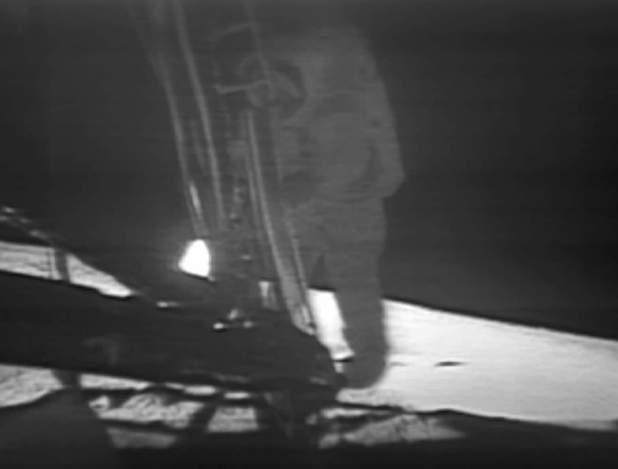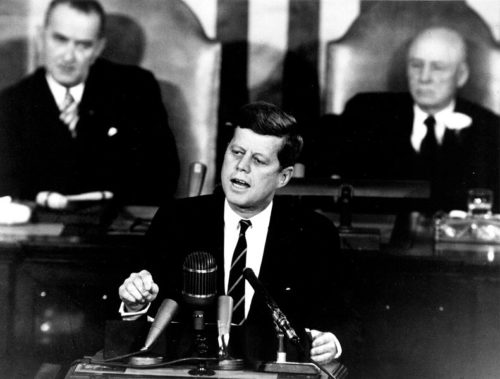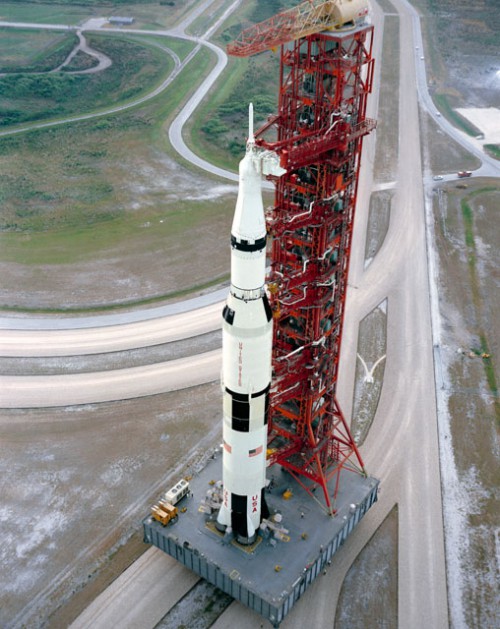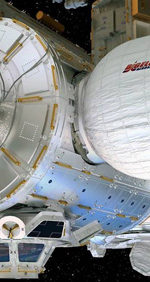
Fifty-five years ago, this week, John Fitzgerald Kennedy—35th President of the United States—gave a speech before Congress which, arguably, defined not only his administration, but also the hopes and dreams of America itself. The 43-year-old president had only assumed office a few months earlier and had been severely tested when Yuri Gagarin became the first man in space and a CIA effort to support the overthrow of Fidel Castro had fallen catastrophically to pieces. In the aftermath of both of these events, Alan Shepard became the first American in space, albeit on a suborbital “hop,” lasting barely 15 minutes. As outlined in yesterday’s AmericaSpace history article, it was a combination of this and other factors which drove Kennedy to commit his nation to landing a man on the Moon.
On 25 May 1961, the president stood before a joint session of Congress and publicly declared his vision. He knew, after recommendations from both NASA Administrator Jim Webb and Secretary of Defense McNamara, that the presence of men in space would truly capture the imagination of the world. The first part of his speech focused upon ways in which the United States could exploit its economic and social progress against Communism, then called for increased funding to protect Americans from a possible nuclear strike. Lastly, Kennedy hit Congress with his lunar bombshell. “I believe,” he told them, “that this nation should commit itself to achieving the goal, before this decade is out, of landing a man on the Moon and returning him safely to the Earth. No single space project in this period would be more impressive to mankind or more important for the long-range exploration of space. And none would be so difficult or expensive to accomplish.”

Expense, indeed, was the major stumbling block. Following budgetary meetings with Webb in March 1961, Kennedy had requested a revised Fiscal Year (FY) 1962 budget for NASA, increasing it more than $125 million over the Eisenhower administration’s recommended $1.11 billion. By the end of 1961, NASA’s budget would grow to more than $5 billion, some 10 times as much as had been spent on space research in the past eight years combined and roughly equivalent to 50 cents per taxpayer. Kennedy acknowledged that it was “a staggering sum,” but reinforced that most Americans spent more each week on cigars and cigarettes. Still, he would have to face harsh criticism by placing the lunar goal ahead of educational projects and other social welfare efforts for which he had campaigned so hard during his years in the Senate. He would admit in his speech that he “came to this conclusion with some reluctance” and that the nation would have to “bear the burdens” of the dream.
Kennedy met almost no internal opposition from both the Senate and the House of Representatives, but others did not wish to accept such burdens. Immediately after the speech, a Gallup poll revealed that just 42 percent of Americans supported the drive for the Moon. Yet the president also gained immense support, both as a risk-taker and as a statesman. The decision, said his science advisor Jerome Wiesner, was one that he made “cold-bloodedly.” It was also a decision that he firmly stood by. Only hours after Virgil “Gus” Grissom flew America’s second suborbital mission on 21 July 1961, Kennedy signed into law an approximately $1.7 billion appropriation act for Project Apollo. In a subsequent address, given at Rice University in September 1962, he admitted that Apollo and Saturn would contain some components still awaiting invention, but remained fixed in his determination to “set sail on this new sea,” because “there is new knowledge to be gained and new rights to be won.”
The overall picture still seemed to show that Kennedy was broadly supportive of the lunar goal, although taped conversations with Jim Webb—now ensconced in the John F. Kennedy Presidential Library and Museum in Boston, Mass.—imply otherwise. In November 1962, at a meeting to discuss the space budget, Kennedy categorically told Webb that he was “not that interested in space” and that his stance in support of the program was based purely on the need to beat the Soviets. Nonetheless, he had approached Nikita Khrushchev on two occasions—in June 1961 and again in 1963—to discuss space co-operation; in the first case, his entreaties fell on deaf ears, but in the second case, the Soviet premier responded with greater warmth.

Still, there remained doubts in large swathes of the American populace about the lunar goal. In April 1963, Kennedy had asked Vice-President Lyndon Johnson—in his capacity as head of the National Aeronautics and Space Council (NASC)—to review Project Apollo’s progress. “By asking Johnson to conduct the review, Kennedy was virtually assured of a positive reply,” wrote space policy analyst Dwayne Day in a 2006 article for The Space Review. “Furthermore, Kennedy’s request in effect ruled out cutting Apollo so as not to ‘compromise the timetable for the first manned lunar landing.’” In his report, Johnson advised that, if cuts were to be made to NASA, they ought to be diverted to safeguard Apollo.
A few days after Kennedy’s 20 September 1963 speech to the United Nations General Assembly—in which he proposed a “joint expedition to the Moon”—Congressman Albert Thomas, chair of the House Appropriations Subcommittee on Independent Offices, wrote to the president and asked if he had altered his position on the lunar landing. Kennedy replied that the United States could only co-operate in space from a position of strength, but shortly before his assassination he asked the Bureau of the Budget to prepare a report on NASA. A draft of this report, which addressed the question of “backing off from the manned lunar landing goal” was written in early 1964 and still exists. In his analysis, Day posited that this was the very question that Kennedy had asked them to consider. The bureau’s consensus was that the only basis for backing off from Apollo, aside from technical or international situations, would be “an overriding fiscal decision.”
Throughout the Sixties, and long after Kennedy’s death, the road to the Moon remained fraught with danger and risk. Several astronauts lost their lives in training accidents, and the Apollo 1 crew died during a “plugs-out” ground test in January 1967, putting the program on hold for almost two years. The pace at which the United States moved from suborbital missions in early 1961 to Earth-orbital rendezvous in 1965 to the first piloted voyage to the Moon in 1968 to the first landing itself in 1969 remains one of the most phenomenal feats in the history of human accomplishment. Four percent of the federal budget had much to do with this pace, but it puts several of our subsequent efforts to return humans to the Moon to shame.
Twenty-four hours before the paths of the president and his assassin, Lee Harvey Oswald, tragically intertwined, on 21 November 1963, Kennedy recounted a story to an audience in San Antonio, Texas. Reminding them that it was still “a time for pathfinders and pioneers,” he told the tale of a group of Irish boys who reached an orchard wall and were dismayed that it was too tall to scale. Throwing their caps over the wall, they presented themselves with no choice but to force themselves to scale it. “This nation,” Kennedy explained, “has tossed its cap over the wall of space and we have no choice but to follow it. Whatever the difficulties, they will be overcome.”
And six years after his death, they were. Today, 55 years to the week since Kennedy’s commitment to reach the Moon, it can be hoped that the difficulties and challenges which lie before humanity today can be similarly overcome and a return of humans to the Moon, and perhaps also to Mars, can be accomplished in our lifetimes. Only then can we humans cement our credentials as a truly spacefaring civilization.
This is part of a series of history articles which will appear each weekend, barring any major news stories. Next week’s article will focus on the 50th anniversary of Gemini IX-A, which arose from the ashes of tragedy and turned into one of the most challenging human space missions ever undertaken.
Want to keep up-to-date with all things space? Be sure to “Like” AmericaSpace on Facebook and follow us on Twitter: @AmericaSpace






Well done, Ben, well done!
Yep! And Thank you Ben!
“Today, 55 years to the week since Kennedy’s commitment to reach the Moon, it can be hoped that the difficulties and challenges which lie before humanity today can be similarly overcome and a return of humans to the Moon, and perhaps also to Mars, can be accomplished in our lifetimes. Only then can we humans cement our credentials as a truly spacefaring civilization.” From the above nifty article.
“Congress has repeatedly attempted to steer NASA back toward the lunar goals of the 2004 Vision for Space Exploration – in the 2010 Authorization, both cislunar space and the lunar surface were specified as destinations for human missions, direction that the agency adamantly ignored.”
From: ‘The Moon is Again Within Reach – Let’s Grab (and Hold On To) It’ By Paul Spudis on June 1, 2016 At: http://www.spudislunarresources.com/blog/the-moon-is-again-within-reach-lets-grab-and-hold-on-to-it/
If NASA cannot lead the world’s efforts to tap our nearby Lunar resources, it seems exceedingly unlikely that NASA will have the critical skills and international political, technical, scientific, business, and economic support needed to lead humans in exploring and exploiting the resources of Mars and Ceres.
Our Earth needs permanent resource exploration and exploitation bases in the Moon’s polar regions. And NASA’s leadership clearly isn’t leading the human effort of grabbing and holding onto the Moon.
If NASA’s leaders continue to “adamantly” ignore the Lunar focus of our space laws in order to instead ‘lead’ the agency in the direction of being a funding or advertising toy for the billionaire ‘political friends’ of the President, Congress needs to significantly reorganize NASA’s system of leadership.
“Kennedy acknowledged that it was “a staggering sum”, but reinforced that most Americans spent more each week on cigars and cigarettes.”
A look at just a few of the most “important” industries and expenditures illustrate the same lesson. Americans spent 60 billion dollars on their pets in 2015 and 17 billion on tennis shoes. Just for warfighting operations in Afghanistan and Iraq in 2017 The Obama administration has requested $58.8 billion – the Overseas Contingency Operations (OCO) fund—in fiscal year 2017. The new Stealth Bomber contract awarded to Northrop Grumman is expected to exceed 20 billion in development costs before production even starts.
We can afford Super Heavy Lift Vehicles and a Moon base. The only people screaming cheap are the Musk fans and this has, in my view, been incredibly damaging to space exploration. Far more than most people understand. There is no cheap.
Absolutely we can afford an SHLV. For the same price as paying ULA to do it one and expendably, we can get three fully reusable vehicles from SpaceX.
So we should do that.
It would be entertaining and illuminative for the legal discovery process to operate on Gary Church and his several sockpuppets.
Or maybe he’s only a crank who can’t or won’t do math.
I have to wonder if the fact that several recent posts here have closed comments has to do with the fact Gary Church and his several sockpuppets can’t support the arguments he makes with relevant facts, won’t shut up, and odiously pretends replies are an attempt to shut him up…
…when in fact you can’t pay enough money to have better comedy than Gary Church claiming there is no cheap, when there is already cheaper and therefore better, and the cost will go down from here.
I request comments be open, so we can all ignore or enjoy the show, as each prefers.
Eyeballs are money here, after all.
Toxic.
That was comedy.
“…legal discovery process to operate on Gary Church and his several sockpuppets”
Damn it Tom, I’m an engineer not a head headshrinker. But if I had to guess, I’d say there’s nothing to see here, just a bitter old man on VA & SS benefits plus a couple of guys living in mom’s basement.
The only question is, do the sock-puppets use genuine Reynolds Wrap® for their headgear or cheap store brand?
Yes, another truly fact based addition to the conversation; for which you have come to be known.
Thanks for the input.
Let everybody know the next time you want to pontificate on psychoanalysis (a subject on which you admit to knowing nothing) about people you have never met.
You can try the “it’s just humor” dodge (as you usually do), but nobody who does not actually need a “headshrinker” is going to buy it.
You really should look into getting a real “headshrinker” for yourself, but that would require a level of self awareness of which you are obviously not capable.
Joe, these creatures have hijacked all public discourse for years with their bullying and garbage robo-commenting. They are a mob of toxic groupies who absolutely cannot tolerate someone exposing the NewSpace scam. It drives them totally nuts when someone tells the truth about their demi-god and the flagship company. The full spectrum can be seen on this forum- from name-calling to cyberstalking to inferring legal action. The worst bunch of creeps imaginable.
I think we have been through this before, but these guys are classic internet trolls who get some kind of weird pleasure out of insulting people from the safety of distance that the internet provides.
I am not saying to ignore them, but do not let them make you mad. Provoking an angry response is what they want. If you give them one, they think they have won.
Just laugh them off.
It really irritates them and is more than they deserve.
Maybe “It would be entertaining and illuminative for the legal discovery process to operate on” Elon Musk.
What do you pretend is not public which should be?
Since the first reference to use of the “legal discovery process” was yours (at May 30, 2016 at 12:33 pm) and was aimed at posters on this website with which you disagree (along with the usual paranoid prattling about “sockpuppets”); what is it you think those with which you disagree are doing in these comments sections that rise to the level that would invoke the “legal discovery process”?
What crime do you believe they are committing?
If your only excuse is “That was comedy.” skip it. You are just trying to escape the bizarre nature of your original post.
It might be fun to know if, and if so exactly when, Mr. Musk received secret government ‘help’?
It might be fun to know if, and if so exactly when, Mr. Musk received secret government advice?
It might be fun to know if, and if so exactly when, Mr. Musk received secret government money?
It might be fun to know if, and if so exactly when, Mr. Musk and his companies secretly helped a government?
Then again, it might be much more useful to just ignore Mr. Musk.
Yep, “when in fact you can’t pay enough money to have better” inane American government strategic policy than the President and Mr Musk’s demonstration and encouragement of the money making opportunities of the international proliferation of cheap and deadly accurate ‘private’ ICBMs/launchers simply so we can move colonists to Mars, right?
“Personally I think that most people running the space programs around the world are very happy with high launch costs, outside of manufacturing and selling. High launch costs basically keep the riff-raff out and reduce the number of players.”
From Page 11 of ‘Toward a Theory of Space Power: Defining Principles for U.S. Space Policy’ By James Oberg May 20, 2003
What’s good for the goose is good for the gander. Every billionaire and government everywhere on our planet can now fully justify the building of private or public, cheap, low technology, and highly accurate ICBMs/launchers in order to ‘make money in space’.
“World military expenditure in 2012 is estimated to have reached $1.756 trillion” From: ‘World Military Spending’ By Anup Shah
At: http://www.globalissues.org/article/75/world-military-spending
“Over 20 new launch vehicles are being developed to serve this demand.”
And “The global space economy did not contract, even in 2009, and its growth exceeded the general economy in every year except 2010, reaching $330 billion in 2014.” Quotes from: ‘Effects of changing economics on space architecture and engineering’ By Gary Oleson May 16, 2016 At: The Space Review
Lots of big money making opportunities for cheap new ICBM/launcher “players” and plenty of new ICBM security risks and justification for spending trillions on Cold War II.
Yep, an advertising cynic might even think, ‘If we manage to scare enough folks on Earth with nasty, cheap, low tech, ‘private/government’ ICBMs/launchers, then some people may want to leave and be colonists on that cold radiation hell called Mars.’
A critic might even think, What a ‘great’ ‘business model’ and ‘wonderful’ American ‘national strategic policy’: ‘Mess up a beautiful green, blue, and well populated planet by encouraging an endless international proliferation of cheap, deadly accurate, private/government, low technology ICBMs/launchers in order to ‘make money’ by ‘helping’ some folks move to a fourth-rate, risk filled, and radiation rich planet’ called Mars.
The logical path after Apollo was a permanent base on the Moon. The main stumbling block to such a base was the political football that NASA quickly became as Democratic and Republican administrations came and went. In terms of hardware the replacement for the Saturn V first stage was most likely to be reusable twin pressure-fed boosters of several million pounds thrust each. 3 million pound thrust hydrogen engines were in development for the core of a new launcher. The showstopper on the Moon was a lack of water. The aerospace industry was completely satisfied with the profits coming from military hardware and in comparison Human Space Flight, especially Beyond Earth Orbit, was hard money.
The draconian oversight imposed after the Apollo 1 fire was slowly done away with and the convoluted and Byzantine path to the Shuttle began. Chris Lethbridge writes:
“Mathematica reported that two options remained economically feasible for the Booster stage. Either a large solid rocket booster system or a high-pressure liquid fueled Booster system were considered feasible.
A high-pressure liquid fueled series or parallel burn Booster was projected to cost $7 billion to develop and $100 per pound of payload to operate.
A parallel burn Booster utilizing large solid rocket boosters was projected to cost $5.5 billion to develop and $160 per pound of payload to operate.
While the Booster employing large solid rocket boosters would likely be more expensive to operate, NASA opted to take advantage of huge cost savings up front.”
This was the major wrong turn that would cripple the Shuttle, though in truth, going cheap and foregoing an escape system while limiting the configuration to LEO meant the space age was essentially over for decades to come.
I would add that NewSpace is the same pay-for-itself-cargo-bay-of-dreams as the shuttle, just in a cheaper, nastier, less capable package. The empty promises of these bored billionaire hobbyists lead to a dead end in LEO. The showstopper on the Moon, water, is now known to exist there in hundreds of millions of tons of ice. The problem has always been a simple one and concerns a political decision to establish a permanent human presence Beyond Earth Orbit. The reasons to fund such a public works project are many and convincing.
That’s actually toxic.
Toxic is the blind love for cheap, low tech, and highly accurate ICBMs/launchers advocated by our President and Elon Musk and unfortunately funded by reaching deeply into the pockets of American taxpayers.
Obviously, our President and Elon Musk’s strong encouragement of the proliferation of super duper accurate intercontinental Scuds/launchers built everywhere by everyone is sure to enhance the security and peace of mind of every member of our species.
NewSpace is the same pay-for-itself-cargo-bay-of-dreams as the shuttle, just in a cheaper, nastier, less capable package. The empty promises of these bored billionaire hobbyists lead to a dead end in LEO. Anything having to do with hobby rockets and blow up tents and space clowns is…toxic.
Gary mentioned Hobby Rockets! Drink!!
Larry Church –
A drunk is someone who is always looking for any vague excuse to drink.
A drunk once explained to me, “When do you know a drunk is lying? – Whenever his lips are moving.”
I will say a good thing about one drunk. Once, a long time ago when I was still a teenager, an old drunk drunk saved me from fighting with an extremely angry guy that vaguely looked like Superman on steroids.
How did the old drunk drunk save me? He started asking the extremely angry steroidal Superman simple questions.
That quite drunk drunk was obviously wise and brave.
Sometimes I wonder if that old drunk drunk might of been an Angel or an alien or even Mother Teresa’s ‘Christ in his most distressing disguise’.
Why?
I was in a ‘sort of backed into a corner’ situation with nowhere to get help and I was reluctantly determined to fight with the extremely angry Superman on steroids. I was simply waiting until he struck the first blow. Obviously, in such a real fight he might well have seriously injured or even killed me.
Amazingly, after many simple questions from the old drunk drunk, the very angry steroidal Superman calmed down and was quietly talking about his family and crying and crying some more. The old drunk drunk listened patiently.
I went back to continuing my nearby work of removing some paint in an effort to ‘carve’ a nice big peace symbol on a large flat piece of old iron.
Yep, I was saved from big trouble by an old drunk drunk who kept asking simple questions.
And after a few hours, I did finish the peace symbol.
Humans are going back to the Moon to stay and that means we shouldn’t abandon LEO.
“It’s also uncertain, from a public policy standpoint, whether NASA will be allowed to abandon low-Earth orbit without a viable commercial presence in its wake.” From: ‘NASA official warns private sector: We’re moving on from low-Earth orbit’ By Eric Berger 12/7/15
At: ARSTECHNICA
NASA doesn’t seem to have a logical plan that could reduce space transportation risks and costs and thereby accelerate the development of the Moon and the rest of Cislunar Space.
The issue is: How can we evolve the ISS with new and much larger modules to enable it to become a transportation hub to reduce the risks and costs of future Lunar surface and other Cislunar missions?
Our Earth’s magnetic field provides the significant cost reducing option of using electrodynamic thrust for the International Space Station and space tugs.
“Propellantless, reusable space vehicles with virtually unlimited delta-V using solar power and electrodynamic thrust”
And, “Maneuverable over all of low Earth orbit at any inclination”
From: ‘Company Gets $1.9 Million from NASA to Develop Debris Removal Spacecraft’ by Doug Messier on March 12, 2012 At: Parabolic Arc
An electrodynamic thrust cargo tug based at the International Space Station in LEO could be ‘velocity pumped’ during its time near LEO perigee to ever higher and more highly elliptical orbits. The apogee eventually intersects Lunar orbit, or the Lunar surface, with the apogee remaining in LEO.
“Since a propulsive tether expends no propellant, its efficiency will be measured in its cost compared to rockets. And that can be as little as 8 percent the cost of chemical rockets.”
And, “A propulsive tether would weigh about 90 kg (200 lbs.). In turn, it would eliminate the need to haul up to 4,000 kg (8,800 lbs.) of chemical propellants to the station. Atmospheric drag on the station will be about 0.3 to 1.1 newton (depending on the time of year), and the tether could produce 0.5 to 0.8 newton of thrust.” From: ‘Up, Up, and Away (bit by bit)’ At: NASA
If an extensively evolved and much larger International Space Station had an advanced electromagnetic railgun, it could regularly shoot small exploration and supply payloads to the Moon and recover its recoil reduced velocity by the use of a much larger version of the above noted “propulsive tether” that “expends no propellant”.
The evolved ISS could also recover it orbital velocity lost from shooting payloads towards the Moon by shooting payloads in the opposite direction in order to reduce the Earth reentry velocity of such payloads.
“The stats for such a weapon are impressive the current prototypes built by companies such as General atomics and BAE Systems can fire an aerodynamic shell at speeds of Mach 7.5 (5,700 mph / 9,200 km/h), which can reach the horizon in 6 seconds and has much greater range than conventional guns, having a reach of 110 nautical miles (126 mi / 203 km).” From: ‘US Navy announces sea trials for electromagnetic railgun’ By David Szondy April 20, 2014 at Gizmag
That “9,200” km/hour equals about 2.55 kilometers per second. And since
The Moon’s escape velocity is only 2.38 km per second. We could also eventually use Lunar based electromagnetic guns to cheaply shoot Lunar resources and products to the International Space Station and other spacecraft in Earth orbit.
Extensive LEO and Lunar infrastructure is the key to reducing the risks and costs of developing Cislunar Space.
Yep, we are going back to the Moon.
“Peregrine offers mission flexibility with a 30 to 265 kilogram payload capacity. This enables secondary flights on several different launch vehicles. The lander will be powered with an Aerojet Rocketdyne propulsion system featuring next generation space engine technology.”
‘DHL and Airbus Defence and Space Support Astrobotic to Develop Lunar Delivery Service’ From: Press Release Berlin 06/02/2016 At: http://www.dhl.com/en/press/releases/releases_2016/all/dhl_and_airbus_defence_and_space_support_astrobotic_to_develop_lunar_delivery_service.html
“Chris Hadfield, the celebrated Canadian astronaut who famously recorded a cover version of David Bowie’s Space Oddity on the International Space Station, thinks that building a moon base is the ‘natural’ next step in space exploration.
Speaking to Mirror Online ahead of his appearance at the Brain Bar Budapest festival, Hadfield said that space stations like the ISS will one day be used to set up ‘permanent habitation’ on the moon, opening up the doors to further space travel.”
From: ‘Astronaut Chris Hadfield says we should build a MOON BASE to explore the rest of space’
By Sophie Curtis June 3, 2016 At: http://www.mirror.co.uk/science/spaceman-chris-hadfield-says-colonising-8109245
“The Government of Luxembourg is staking 200 million Euros to kick-start the nascent space resources utilization business — prospecting for and eventually mining and selling resources extracted from the Moon, asteroids or other solar system bodies. The country’s Prime Minister and Deputy Prime Minister made the announcement Friday flanked by former European Space Agency (ESA) Director General Jean-Jacques Dordain and former NASA Ames Research Center Director Pete Worden.”
From: ‘Luxembourg Stakes Initial 200 Million Euros to Become Silicon Valley of Space Resources’ By Marcia S. Smith June 4, 2016 At: http://www.spacepolicyonline.com/news/luxembourg-stakes-200-millio-euros-to-become-silicon-valley-of-space-resources